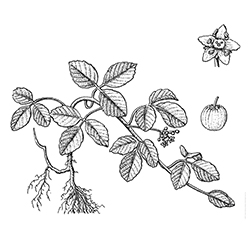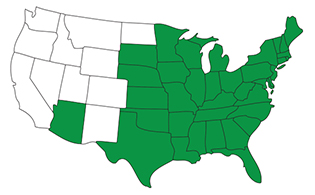

Poison Ivy
Toxicodendron radicans
Poison Ivy (toxicodendron radicans) is a creeping perennial broadleaf weed that is also known as Rhus radicans, Eastern Poison Ivy, Markweed, Poison Creeper, Three-leaved Ivy, Picry and Mercury. This notoriously itchy plant's scientific name is Toxicodendron radicans.
Identifying Poison ivy

Creeping

Pinnately Trifoliolate

Elliptical
A common question is whether poison ivy grows in grass or in your lawn. Poison Ivy does not typically invade mowed lawns, but rather prefers shade along fences and rock walls or in wooded areas. If you suspect Poison Ivy in these areas, do not touch it or try to pull it out by hand. Poison Ivy can be a climbing or trailing broadleaf weed, forming either a deciduous woody shrub or a climbing vine with three leaflets. On older plants, Poison Ivy's aerial roots give the stems a hairy, fibrous appearance. Its leaflet stalks are short, except on the middle leaflet. Poison Ivy produces small, yellowish-green flowers on axillary panicles. This poisonous creeper also forms small white berries containing a single seed. These berries typically remain on the stems through winter. Poison Ivy reproduces using these seeds or by creeping rootstocks and stems that root where they contact the soil.
Life Cycle of Poison Ivy
This broadleaf weed grows throughout the northeastern and midwestern United States. As with other poisonous plants in this family (including Poison Oak), Poison Ivy can cause painful irritation, itchiness and severe allergic reaction upon contact with the skin.

Poison Ivy Control & Removal Services
Small clusters of Toxicodendron radicans plants (or poison ivy) can be removed by hand but only when the plants are young and lack thick, woody stems. Gloves must be worn, and no part of the poison ivy plant should contact the skin while removing the ivy in the grass. Removing larger groupings of poison ivy broadleaf weeds is considerably more difficult, even when using stronger weed control methods. Because Poison Ivy can grow into other woody plants and trees, it is important to use extra caution when applying broadleaf weed killers so that collateral damage to surrounding plants is kept to a minimum.







